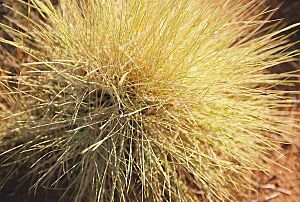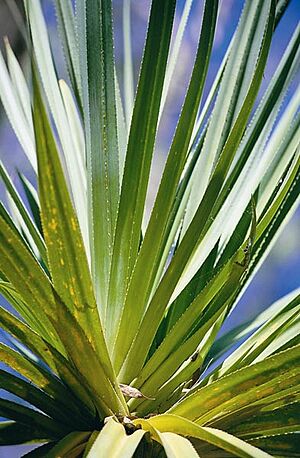Flora of Kakadu National Park facts for kids
Kakadu National Park in Australia's Northern Territory is a truly special place. It's famous for its amazing landscapes, ancient rock art, and incredible wildlife. But did you know it's also home to a huge variety of plants? These plants are super important to the park's ecosystem and have been used by the local Aboriginal people, the Bininj, for thousands of years.
This article will introduce you to some of the cool plants you might find in Kakadu. We'll share their common English names and, where possible, their names in Gun-djeihmi, a language spoken by the Bininj people.
Contents
Trees with Unique Features
Kakadu's trees come in all shapes and sizes, each with something special about them.
Freshwater Mangrove (An-galnggi)
The Barringtonia actuangula, or Freshwater Mangrove, is a small tree that loves to grow near water. You'll find it along creeks, rivers, and swamps. Between September and December, it shows off beautiful hanging, bright-red flowers. Watch out for it though! It's sometimes called the 'itchy tree' because caterpillars that live on its leaves can cause skin irritation if you touch them.
Tropical Banksia (Guibuk)
The Banksia dentata is the only type of Banksia tree found in this part of Australia. It has cool, jagged leaves and the classic banksia flower. These flowers appear from January to April.
Kapok Bush (An-djedj)
The Cochlospermum fraseri, or Kapok Bush, loses its leaves in the dry season, from May to August. When it does, bright-yellow flowers pop out! Later, it grows large, delicate pods filled with a soft, cotton-like material.
Cooktown Ironwood (An-dubang)
Erythrophleum chlorostachys is a tall, spreading tree with distinct round, dark-green leaves. As the dry season ends, it grows new leaves that are a bright lime-green. Its wood is incredibly hard and termites can't eat it. But be careful, all parts of this tree are very poisonous to animals.
Darwin Woollybutt (An-djalen)
The Eucalyptus miniata is a tall gum tree, growing up to 20 meters high. It has rough, dark bark on the bottom half of its trunk and smooth, white bark on the top. Bright-orange flowers bloom between May and August.
Banyan (An-borndi)
Ficus virens is a large, spreading tree known for its aerial roots that hang down and its big prop roots that grow from its main branches. It's a type of strangler fig and provides excellent shade. Its fruits are edible.
Silver-leafed Paperbark (Gun-god)
The Melaleuca argentea is a big, spreading tree often seen along waterways. Its pale-yellow flowers appear mostly between June and October. They have a very sweet smell that attracts many different animals.
Pandanus Trees
Kakadu is home to several types of Pandanus trees, which are easily recognized by their unique spiral leaf arrangement.
- Water Pandanus (An-djimdjim) (Pandanus aquaticus) grows along the banks of permanent freshwater streams. Its fruit cannot be eaten.
- Sandstone Pandanus (An-more) (Pandanus basedowii) is special because it only grows in the rocky sandstone areas of Kakadu and Arnhem Land.
- Spiral Pandanus (An-yakngarra) (Pandanus spiralis) grows in many different places, often in thick groups. Aboriginal people use this plant for medicines, strong fibers, and food.
Water Plants and Lilies
Kakadu's wetlands and billabongs are home to beautiful water plants.
Red Lily (Wurrmarninj)
The Nelumbo nucifera, or Red Lily, grows in the park's lowland wetlands. Its leaves are very large and stand tall above the water. Big, sweet-smelling, deep-pink flowers bloom between March and November.
Blue Lily (Barradjungga)
You'll often see the Nymphaea violacea, or Blue Lily, along the edges of billabongs. Its white flowers have violet tips and appear from January to July. You can eat its seeds and stems raw, and its underground bulbs can be cooked and eaten too.
Plants with Edible or Useful Parts
Many plants in Kakadu have been important food sources or tools for Aboriginal people for a very long time.
Green Plum (An-dudjmi)
The Buchanania obovata is a medium-sized tree with large, thick, leathery leaves. From October to December, it produces bunches of green, grape-sized plums. These are considered some of the best 'bush tucker' (wild food) around!
Sand Palm (An-gulalurrudj)
The Livistona humilis is a slender fan palm with small yellow flowers on long spikes. Aboriginal people use this palm for traditional medicines, strong fibers, dyes, and food.
Billy Goat Plum (An-morlak)
The Terminalia ferdinandiana is also known as the Kakadu plum. It's a medium-sized tree with big, broad leaves. It loses its leaves in the dry season. Between March and June, it grows edible fruits that are known to have extremely high levels of Vitamin C. Outside of Kakadu, this plum is harvested and sold commercially.
Other Interesting Plants
Native Ginger
Curcuma australasica is an attractive leafy plant that grows from a tuber, similar to the turmeric plant from Asia. Its bright pink flowers can be seen at famous rock art sites like Ubirr and Nourlangie Rock during the wet season.
Turkey Bush (Anbarndarr)
The Calytrix exstipulata is common across the lowlands of Kakadu. It produces masses of beautiful pink-purple flowers between May and August.
Spear Grass (An-ngulubu)
Sorghum spp., or Spear Grass, can grow to over 2 meters tall. It becomes the main plant in the undergrowth towards the end of the wet season.
Yellow Bladderwort
Utricularia fulva is a small plant that looks a bit like an orchid. It grows along sandy creek banks.
Kakadu National Park is a treasure trove of plant life, each species playing a vital role in its unique environment. Learning about these plants helps us appreciate the park even more!




